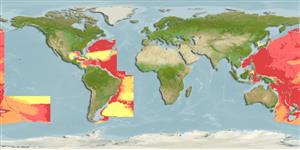Classification / Names
आम नाम | उपशब्द | Catalog of Fishes(वर्ग, प्रजाति) | ITIS | CoL | WoRMS | Cloffa
>
Lophiiformes (Anglerfishes) >
Himantolophidae (Footballfishes)
Etymology: Himantolophus: Greek, himas or himantos = leather strap, thong or leash (referring to the thick leathery illicium) + Greek, lopho or lophio = crest or tuft (referring to the baited illicium projecting from the head) (Ref. 86949).
More on author: Regan.
Environment: milieu / climate zone / गहराई सीमा / distribution range
पारिस्थितिकी
समुद्री बैथीपिलाजिक; गहराई सीमा ? - 3000 m (Ref. 40966). Deep-water
North Atlantic.
आकार / वज़न / Age
परिपक्व अवधि: Lm ? range ? - ? cm
Max length : 4.0 cm TL पुल्लिंग / अलिंग; (Ref. 44404)
Short description
पहचान कुंजी | आकृति विज्ञान | मौरफोमैटरिक्स
Males differ from those of H. appelii and the H. rostratus by the following combination of characters, olfactory lamellae 10-13, greatest diameter of posterior nostril 3.3-5.5% SL, length of snout 13-17% SL, 16-31 upper and ~20-38 lower denticular teeth (Ref. 53724).
Body shape (shape guide): short and / or deep.
Minimum depth from Ref. 58018.
Life cycle and mating behavior
परिपक्व अवधि | पुनरुत्पत्ति | मछलीऔ का अंडे देना | अंडे | Fecundity | लार्वा
Regan, C.T., 1925. New ceratioid fishes from the N. Atlantic, the Caribbean Sea, and the Gulf of Panama, collected by the 'Dana.'. Ann. Mag. Nat. Hist. (Ser. 9), 15(89):561-567. (Ref. 44404)
IUCN Red List Status (Ref. 130435: Version 2025-1)
Threat to humans
Harmless
Human uses
साधन
Special reports
Download XML
इंटरनेट स्रोत
Estimates based on models
Preferred temperature (संदर्भ
123201): 2.3 - 4.3, mean 3.2 °C (based on 875 cells).
Phylogenetic diversity index (संदर्भ
82804): PD
50 = 0.5000 [Uniqueness, from 0.5 = low to 2.0 = high].
Bayesian length-weight: a=0.01995 (0.00906 - 0.04395), b=3.01 (2.83 - 3.19), in cm total length, based on all LWR estimates for this body shape (Ref.
93245).
Trophic level (संदर्भ
69278): 3.4 ±0.6 se; based on size and trophs of closest relatives
Fishing Vulnerability (Ref.
59153): Low vulnerability (10 of 100).
🛈
